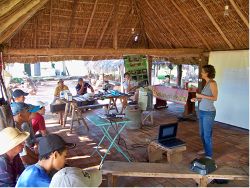Goals
White Lipped Peccaries
Overall Goal: Conserve white-lipped peccary populations in the Pantanal and Cerrado by halting deforestation and habitat conversions and reducing the environmental impact of ranching. The project objectives includes:

- accessing the presence/absence of white lipped peccaries in the Pantanal and on the Cerrado highland plateaus of the Pantanal with the goal of understanding the degree to which WLP presence/absence is associated with land use practices, fragment size and diversity of habitats;
- evaluating the movements of WLP between the Cerrado highlands and Pantanal basin to identify wildlife/peccary ecological corridors and the environmental variables associated with these corridors;
-
evaluating the seasonal patterns of resource availability and use by
WLP and other frugivores.
For the past 13 years, we’ve been studying peccary ecology, population genetics, and infectious disease evaluation in the Pantanal of Brazil, a region where continuous tracts of wildlife habitat still exist. We are also investigating the effects of deforestation on
peccaries within the Pantanal and in the highly fragmented Cerrado by comparing data from the Atlantic forest with collaborating researchers.
These contrasts should help clarify how the ecology and behavior of peccaries are altered in fragmented landscapes. Finally, because peccaries require large ranges and use a variety of habitat types, conservation efforts that target them will benefit a wide range of other species.
The project presented proposes to evaluate the direct and indirect impacts of a changing cattle industry on key species, and their resources, in the Pantanal and its surrounding highlands. Inadequate and inefficient management practices are placing great pressure on natural resources in the Brazilian Pantanal and are driving harmful habitat conversions and the decline of important landscape wildlife.
Because the Pantanal is a diverse, productive ecosystem of spatial and temporal extremes, it will be important to carry out similar studies in areas that differ with respect to resources (i.e. vegetation/habitat types) and land-use practices. To accomplish this, we are expanding the scope of the study to include additional sites with collaborating researchers.